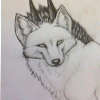
This year the raptor center where I volunteer sadly lost one of their oldest birds to old age. Kisra, the American Kestrel, was found in her nest box one morning, as if in peaceful sleep. She was very old (at least 14 years old), and during her life with Horizon Wings she taught countless children and adults about how to help conserve kestrel habitat and prevent birds from hitting windows and becoming injured, which is the injury which caused Kisra to lose part of her wing back in 2000 when she was found.
She also was the first bird for many of the volunteers to handle while learning to work with the birds. She was calm, patient and forgiving of mistakes. Earlier this year, the decision was made to retire her from programs and remove her anklets, so she could live the rest of her life in peace.
She will certainly be missed, and I've never met any kestrel quite like her. May she fly free wherever the wind has taken her.
Acrylic on matboard, 5X7 inches.
A note about her coloration - in her old age, her plumage began to grow grayer and duller, and as a result she began to look more male in her face. In case anyone is confused about the lack of a red patch on her head and the bluish-gray of her head, this is simply the way her plumage was.
She also was the first bird for many of the volunteers to handle while learning to work with the birds. She was calm, patient and forgiving of mistakes. Earlier this year, the decision was made to retire her from programs and remove her anklets, so she could live the rest of her life in peace.
She will certainly be missed, and I've never met any kestrel quite like her. May she fly free wherever the wind has taken her.
Acrylic on matboard, 5X7 inches.
A note about her coloration - in her old age, her plumage began to grow grayer and duller, and as a result she began to look more male in her face. In case anyone is confused about the lack of a red patch on her head and the bluish-gray of her head, this is simply the way her plumage was.
Category Artwork (Traditional) / Animal related (non-anthro)
Species Falcon
Size 530 x 750px
File Size 396.2 kB
Listed in Folders
Sorry you lost your little buddy. :< Interesting, though, that you saw that plumage change. In my 25-year avian medicine career, I've run across this same phenomenon mainly in waterfowl. I've suspected it in raptors but most species are not sexually dimorphic beyond body mass differences, so it's harder to be certain. In waterfowl, a female can completely change coloration to male although they still retain bill color and female quack (can't really grow the syringeal bulla that males possess). Totally makes sense that as the ovarian follicles are depleted, there's less estrogen and so successive molts reflect less estrogenic influence. I'd love to see pics of this bird if you can share or send me links to them on the organization's website.
Kisra sounds like a beautiful female American Kestrel. I'm so very sorry for your loss.
I'm reminded about my own organization's loss of American Kestrel life -- either due to old age or unfortunate circumstances. It's never easy to deal with the loss of a raptor's life (especially one who is loved and has been a cherished ambassador in the education program). I bow my head down in silence to remember your beloved Kisra. May she forever be free to head-bob, tail-flick and let loose her signature American Kestrel trill.
I'm reminded about my own organization's loss of American Kestrel life -- either due to old age or unfortunate circumstances. It's never easy to deal with the loss of a raptor's life (especially one who is loved and has been a cherished ambassador in the education program). I bow my head down in silence to remember your beloved Kisra. May she forever be free to head-bob, tail-flick and let loose her signature American Kestrel trill.
For some reason I never saw this message. Sorry about that! And thank you :) Kisra was very subdued and calm compared to other kestrels. I always saw her as a 'proper lady' who acted with elegance and manners. Our male kestrel bobs and kikikikis all the time, but she was always very quiet and very still, and would always seem to watch and observe.
At the park I volunteer at, we used to have the most charming little male kestrel. He was a partial wing amputee, but like Kisra, was super-docile on the glove and was everyone's "starter bird". Sadly, last fall, we had a sudden cold snap and didn't prepare his heated box for him. We think it was a combination of cold and his age (he was 9) that did it.
It's amazing how these tiny birds can leave such a big hole in your heart.
It's amazing how these tiny birds can leave such a big hole in your heart.

 FA+
FA+








![[koh]](http://a.furaffinity.net/1427867562/%5Bkoh%5D.gif)









Comments